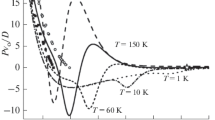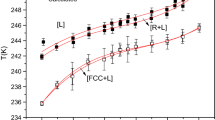Abstract
The problem of appearance and disappearance of the S-loop of the first-order phase transition (PT) in an isotherm of the equation of state near the crystal–liquid (CL) PT was studied using the three-phase model of a simple matter. The calculations carrier out for argon is shown that the S-loop of CL PT in an isotherm of the equation of state appears because of a sharp decrease and subsequent increase in the pressure related to the formation of delocalized atoms as the specific volume increases isothermally. As temperature increases, the pressure in an isotherm related to the delocalization of atoms transits from the negative region (where it compresses the system) to the positive region (where is stretches the system). Such a behavior of this function leads to the formation of the S-loop of CL PT in an isotherm of the equation of state and also to the disappearance of the S-loop of CL PT at high temperatures with the formation of the critical point of CL PT. The change in the parameters of the CL PT critical point is studied as the number of atoms in the nanosystem decreases. It was shown the critical temperature and pressure decrease in going to a nanosystem, and the critical molar volume increases. The calculations in terms of the three-phase model of a simple matter show that the structure in the CL PT critical point is close to the amorphous packing. The parameters of this amorphous structure in the CL PT critical point are changed slightly as the number of atoms in the nanosystem decreases.



Similar content being viewed by others
REFERENCES
A. R. Ubbelohde, Melting and Crystal Structure (Clarendon, Oxford, 1965).
J. Bilgram, Phys. Rep. 153, 1 (1987). https://doi.org/10.1016/0370-1573(87)90047-0
L. D. Landau, Phys. Z. Sowjetunion 11, 26 (1937).
L. D. Landau and E. M. Lifshitz, Course of Theoretical Physics, Vol. 5: Statistical Physics (Pergamon, Oxford, 1980; Nauka, Moscow, 1976).
J. Frenkel, Kinetic Theory of Liquids (Oxford Univ., London, 1946; Nauka, Leningrad, 1975).
S. M. Stishov, Sov. Phys. Usp. 17, 625 (1975). https://doi.org/10.1070/PU1975v017n05ABEH004361
L. B. Robinson, V. S. T. Au-Yeung, and H. A. Yassen, Phys. Rev. B 21, 2352 (1980). https://doi.org/10.1103/PhysRevB.21.2352
Yu. L. Klimontovich, Statistical Physics (Nauka, Moscow, 1982) [in Russian].
A. Aitta, J. Stat. Mech.: Theory Exp. 2006, P12015 (2006). https://doi.org/10.1088/1742-5468/2006/12/P12015
J. Kierfeld and V. Vinokur, Phys. Rev. B 61, R14928 (2000). https://doi.org/10.1103/physrevb.61.r14928
V. V. Prut, Tech. Phys. 53, 668 (2008). https://doi.org/10.1134/S1063784208050241
M. Elenius and M. Dzugutov, J. Chem. Phys. 131, 104502 (2009). https://doi.org/10.1063/1.3213616
M. N. Magomedov, Vestn. MGTU im. Baumana, Ser. Estestv. Nauki No. 2, 28 (2013) [in Russian].
K. Mochizuki and K. Koga, Phys. Chem. Chem. Phys. 17, 18437 (2015). https://doi.org/10.1039/c5cp02568k
D. A. Kirzhnits, Sov. Phys. Usp. 14, 512 (1972). https://doi.org/10.1070/PU1972v014n04ABEH004734
S. M. Sharma and S. K. Sikka, Prog. Mater. Sci. 40, 1 (1996). https://doi.org/10.1016/0079-6425(95)00006-2
G. Shen and H. K. Mao, Rep. Prog. Phys. 80, 016101 (2016). https://doi.org/10.1088/1361-6633/80/1/016101
S. A. Kukushkin and A. V. Osipov, Inorg. Mater. 35, 551 (1999).
M. N. Magomedov, J. Mol. Liq. 285, 106 (2019). https://doi.org/10.1016/j.molliq.2019.04.032
M. N. Magomedov, Semiconductors 42, 1133 (2008). https://doi.org/10.1134/S1063782608100011
M. N. Magomedov, Phys. Met. Metallogr. 114, 207 (2013). https://doi.org/10.1134/S0031918X13030113
M. N. Magomedov, Semiconductors 44, 271 (2010). https://doi.org/10.1134/S1063782610030012
J. O. Hirschfelder, Ch. F. Curtiss, and B. B. Bird, Molecular Theory of Gases and Liquids (Wiley, New York, 1954).
M. N. Magomedov, Phys. Solid State 45, 32 (2003). https://doi.org/10.1134/1.1537405
L. A. Girifalco, Statistical Physics of Materials (Wiley, New York, 1973).
S. M. Stishov, Sov. Phys. Usp. 31, 52 (1988). https://doi.org/10.1070/PU1988v031n01ABEH002535
M. N. Magomedov, High Temp. 44, 513 (2006). https://doi.org/10.1007/s10740-006-0064-5
N. H. March and N. P. Tosi, Introduction to Liquid State Physics (World Scientific, London, 2002).
G. J. Mikolaj and C. J. Pings, J. Chem. Phys. 46, 1401 (1967). https://doi.org/10.1063/1.1840864
M. Hanifpour, N. Francois, V. Robins, A. Kingston, S. V. Allaei, and M. Saadatfar, Phys. Rev. E 91, 062202 (2015). https://doi.org/10.1103/PhysRevE.91.062202
M. N. Magomedov, J. Non-Cryst. Solids 546, 120263 (2020). https://doi.org/10.1016/j.jnoncrysol.2020.120263
M. N. Magomedov, Crystallogr. Rep. 62, 480 (2017). https://doi.org/10.1134/S1063774517030142
G. J. Zarragoicoechea and V. A. Kuz, Phys. Rev. E 65, 021110 (2002). https://doi.org/10.1103/PhysRevE.65.021110
A. W. Islam, T. W. Patzek, and A. Y. Sun, J. Nat. Gas Sci. Eng. 25, 134 (2015). https://doi.org/10.1016/j.jngse.2015.04.035
ACKNOWLEDGMENTS
The author is grateful to S.P. Kramynin, N.Sh. Gazanova, Z.M. Surkhaeva, and M.M. Gadzhieva for useful discussion and the assistance in the work.
Funding
This work was supported by the Russian Foundation for Basic Research, project no. 18-29-11013_mk.
Author information
Authors and Affiliations
Corresponding author
Ethics declarations
The author declares that he has no conflicts of interest.
Additional information
Translated by Yu. Ryzhkov
Rights and permissions
About this article
Cite this article
Magomedov, M.N. On the Critical Melting Point of a Simple Matter. Phys. Solid State 63, 1048–1057 (2021). https://doi.org/10.1134/S1063783421070167
Received:
Revised:
Accepted:
Published:
Issue Date:
DOI: https://doi.org/10.1134/S1063783421070167




